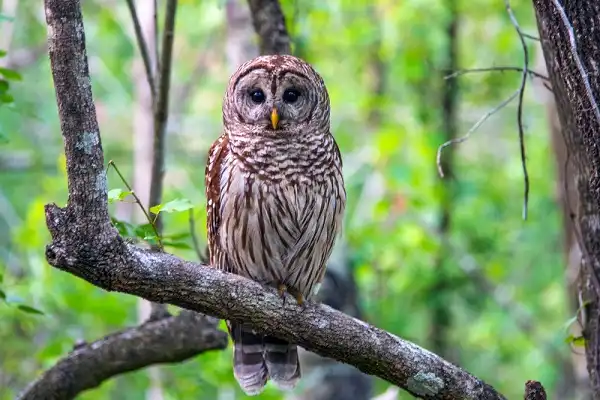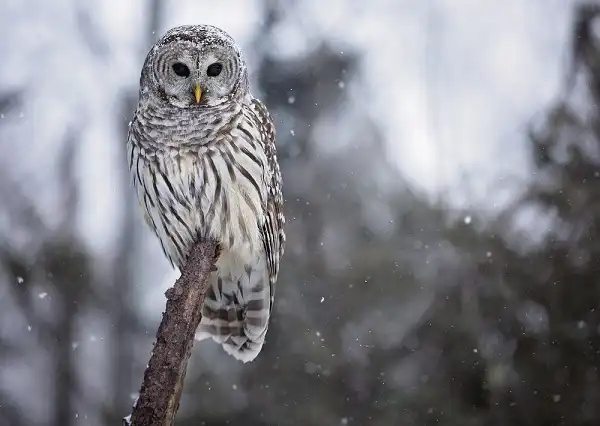The barred owl is a fascinating creature and one that is not often seen in the wild. These owls are known for their unique vocalizations, which include a distinctive hooting sound. Barred owls are also interesting because they are one of the few owl species that are active during the daytime. In this blog post, we’ll take a closer look at the barred owl and learn more about this amazing bird.

Barred Owl Description
The Barred Owl is a large owl. They have bold brown and white striping on their feathers which gives them the classic “barred” look. The head of the barred owl is round and lacks ear tufts, unlike most other species of owls. Their facial disk is also pale with fine streaks, and they have yellow eyes that contrast well with their dark beak. These owls are especially vocal during mating season which usually begins in late winter or early spring. Males give a low hooting sound while females respond with high-pitched barking sounds which helps them find one another during the breeding season. The female will usually lay 2-4 eggs in a shallow depression which she lines with feathers from her own body before incubating them for 28 days until they hatch. Barred owls typically raise one brood per year with both parents helping to feed the young until they fledge about 4 weeks after hatching.
Barred Owl Habitat
The barred owl is a habitat generalist, meaning it can adapt to a variety of different natural habitats. They are most commonly found in deciduous and mixed forests, but also inhabit coniferous forests and even wetland areas near human development. These owls prefer mature forests as they provide plenty of nesting sites and food sources. Trees preferred by barred owls for nesting include Oaks, Maples, Hickories, Birches, Poplars, Sycamores and Walnuts. In addition to the trees necessary for nesting sites, the barred owl needs plenty of food sources. They usually remain hidden due to their nocturnal activity patterns that make them difficult to spot during the day. Those lucky enough to catch a glimpse of this species soaring through the night sky or perched atop a nearby tree branch will surely be astonished by its beauty!
Barred Owl Diet
The barred owl has a varied diet that consists of various small mammals, birds, amphibians, and insects. Their most common prey items are mice, voles, and other small rodents. They also feed on quail, ducks, frogs, salamanders, and a variety of insects such as moths and beetles. Barred owls have sharp talons and powerful beaks that allow them to capture prey up to the size of a rabbit. They are also known to eat larger prey such as snakes or fish in rare cases. In addition to their diet composed mainly of small mammals and birds, barred owls will occasionally scavenge on carrion (dead animals) when they can find it. This species is highly opportunistic when it comes to food sources and will take advantage of whatever food is available in its range. Overall, the barred owl’s diet helps make this species an extremely successful hunter as well as unique among other members of its family due to its wide range of hunted items throughout different types of natural habitats – from deciduous forests mixed with coniferous trees all the way through wetland areas near human development!

Barred Owl Size
The barred owl is a medium-sized species of owl that typically measures between 16 to 25 inches in length from head to tail. Its wingspan usually ranges from 34 to 43 inches, making it one of the larger owl species found in North America. On average, they weigh between 1 and 2 pounds, with males being slightly smaller than females. Barred owls are incredibly agile fliers due to their lightweight bodies and broad wings; they are able to maneuver quickly through the air without expending much energy. In addition to their power of flight, barred owls possess extremely sharp vision that allow them to spot prey even in dim light conditions – making them effective nocturnal hunters who often feed on small mammals like mice and voles as well as amphibians like frogs or salamanders plus insects such as moths or beetles.
Barred Owl Lifespan
The average lifespan of a barred owl is between 4 and 15 years in the wild, although those living in captivity can live for up to 20 years. These birds reach physical maturity around 3 years old and typically mate for life, with pairs often staying together for several years. Barred owls are one of the longest-lived species of owls in North America and have been known to survive in some areas for over two decades. The barred owl is an important part of many ecosystems across North America due to its role in controlling rodent populations while also providing food for larger predators such as hawks or eagles; however they are vulnerable due to habitat destruction and fragmentation caused by urbanization which limits the number of resources available for these birds’ survival. Barred owls are also incredibly resilient creatures that often persist despite changing environmental conditions; however they face various threats which include habitat destruction from logging activities or urban development; collisions with vehicles; predation from larger raptors such as hawks or eagles; illegal hunting or trapping; competition with other avian species; and poisoning due to consuming rats that have ingested rodenticides.
Barred Owl Behavior
The behavior of barred owls varies from individual to individual, but they are generally solitary animals, spending the majority of their time alone. During the breeding season, however, males and females will come together for breeding purposes, with pairs staying together for multiple years. They have a wide variety of vocalizations that can be heard throughout the day and night; these include hoots, barks, screams and whistles which are used for communication as well as to ward off intruders or draw attention to potential prey. Barred owls are also known to be very territorial when it comes to their home ranges; they will often defend their territory vigorously against other barred owls and even larger birds such as hawks or eagles in order to maintain exclusive access to food sources in their area.

Barred Owl Speed
Barred Owls are surprisingly fast and agile flyers, capable of reaching speeds of up to 40 mph (64 km/h) while in the air. This impressive speed allows them to rapidly pursue their prey and escape potential predators with ease. To achieve this level of performance they use powerful wing beats, which generate enough lift to support their compact bodies in the air. They also possess an incredible amount of agility, allowing them to make sharp turns and sudden changes in direction while flying at high speeds. The sheer power and speed of barred owls is truly amazing – it is no wonder why they are so successful hunters in the wild! However, despite their impressive abilities, these birds still face threats from habitat destruction and human activities; thus it is important that steps are taken towards preserving their natural habitats so that future generations may continue enjoying the sight of these magnificent creatures soaring through the sky.
Barred Owl Hunting
Barred owls are highly-skilled hunters that rely on their sharp senses and swift speed to catch their prey. They primarily hunt at night when it is dark, using their excellent eyesight and hearing to locate potential meals. When the owl sees a small animal, like a mouse or vole, it will swoop down and dive towards its target before snatching it up in its talons. Barred owls have also been known to use tools like twigs to help capture its meal – an example of intelligence that other birds cannot match! In addition to hunting on land, these birds also have the ability to hunt in water – something not seen in many other owl species. Using their wings as paddles and talons as nets, they are able to snatch small fish from rivers or lakes with remarkable accuracy and efficiency. This extra source of food allows them to survive in areas where land prey may be scarce. Barred owls are also masterful predators due to their stealthy hunting strategies – they utilize a “sit-and-wait” approach which allows them to remain undetected while waiting for prey items to pass by within striking distance. Once within reach they pounce with lightning quickness before seizing the victim with talons strong enough to break bones! This makes them incredibly efficient predators capable of catching more than one meal per night if needed.

Conclusion
The barred owl is an impressive and unique species of bird that has adapted to thrive in many different habitats across North America. With their powerful wings, sharp senses and remarkable hunting skills, these birds have been able to survive and even flourish despite human activities such as habitat destruction. By conserving the areas where they live and taking steps to protect them from harm, we can ensure that future generations will be able to continue enjoying their awe inspiring prowess for years to come! We should all strive to preserve the beautiful barred owl so it can remain a treasured part of our natural world.
Frequently Asked Question

